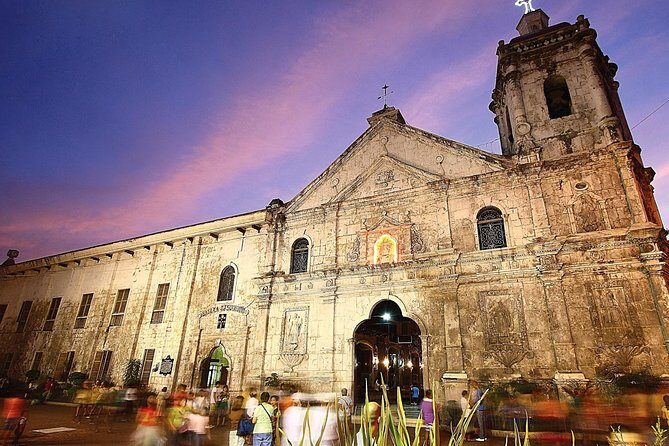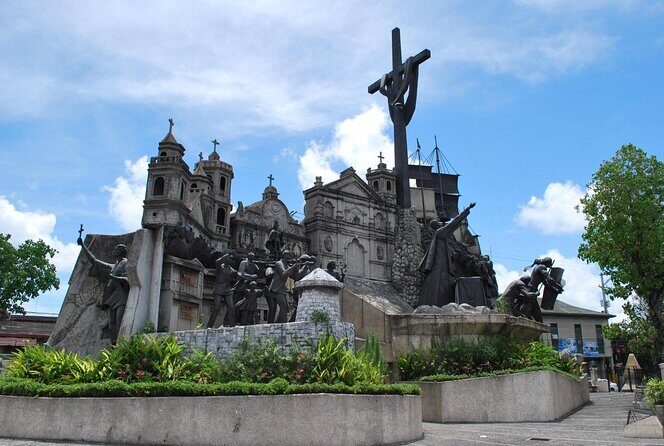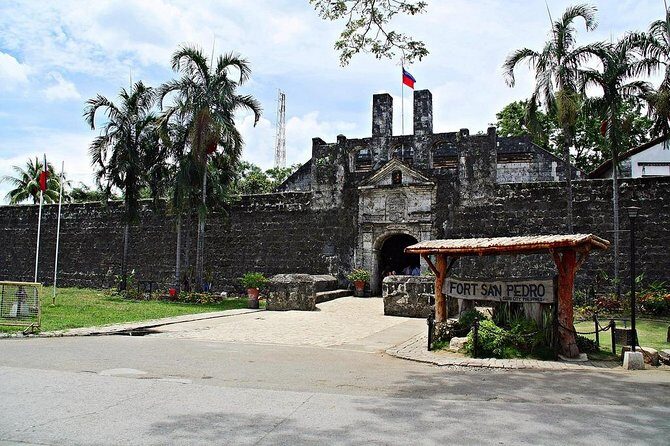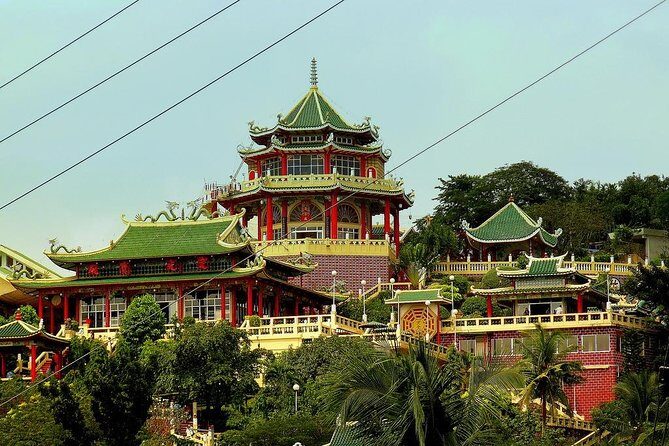Physical Address
304 North Cardinal St.
Dorchester Center, MA 02124
Physical Address
304 North Cardinal St.
Dorchester Center, MA 02124

Discover Cebu's history in a private, 4-5 hour tour covering key sites like Fort San Pedro and Magellan's Cross with a local guide, all inclusive.

If you’re looking to uncover the story behind the Philippines’ oldest city without the hassle of planning every detail yourself, the Cebu City Historical Tour offers a convenient, well-rounded way to do so. This private half-day experience is packed with visits to iconic landmarks like Fort San Pedro, Magellan’s Cross, and the Taoist Temple, all led by a local driver-guide. The best part? Everything is included — from entrance fees to hotel pickup — making it a straightforward way to get a taste of Cebu’s deep-rooted history.
One thing we particularly appreciate about this tour is how personalized the experience feels. Since it’s private, you get to set the pace and focus on the sites that interest you most. Plus, with a local guide behind the wheel, you’ll gain insights and stories that you won’t find in guidebooks. The downside? The tour is quite structured, so if you’re looking for a more adventurous or unplanned exploration, this might feel a touch restrictive.
This tour suits travelers who prefer a cost-effective, hassle-free way to see main historical highlights in Cebu and value a guide’s local perspective. It’s especially ideal for first-timers or those with limited time but eager to learn about Cebu’s fascinating past.

History buffs will find these Cebu heritage tours enlightening

Starting at 9:00 am, this tour kicks off with hotel pickup within the Tri-Cities area, which includes Mandaue, Lapu-Lapu, and Cebu. This offers travelers the convenience of not having to worry about transportation logistics, especially after a possibly early morning flight or check-in. The compact 4-5 hour window is ideal for those on a tight schedule or seeking a relaxed, manageable exploration.
Your first stop is the Santo Niño Basilica, founded in 1565 by Fray Andrés de Urdaneta and Fray Diego de Herrera. This basilica is not only the oldest Roman Catholic church in the Philippines, but it also houses the revered Santo Niño image — a symbol of Cebu’s spiritual and cultural roots. We loved seeing the vibrant church façade and imagining the hundreds of years of ceremonies that have taken place inside. Entry is free, making it an accessible start to your history tour.
Next up is Fort San Pedro, often touted as the oldest and smallest fort in the Philippines. Its triangular walls, about 20 feet high and 8 feet thick, are a tangible reminder of Cebu’s strategic importance during the Spanish era. What makes this stop special is not just the historical significance but the chance to walk along the well-preserved ramparts and imagine the soldiers of old. Although the fort’s area is only around 2,025 square meters, it offers a compact but immersive experience. Admission is free, but take note — it’s a quick stop that leaves you wanting more of Cebu’s military history.
History buffs will appreciate the Yap-Sandiego House, built circa 1680 from wood and coral stone. The house itself is a living museum, showcasing Spanish and Chinese architectural influences, with an interior filled with antique furniture, religious art, and curios. Inside, the guide points out details that reveal the social life of Cebu’s elite during the colonial period. Valued at including admission, this stop earns high marks for authenticity and visual intrigue, offering a glimpse into Cebu’s aristocratic past.
Reviewers highlight the atmosphere of this house: “The atmospheric Yap-Sandiego Ancestral House is among the country’s oldest residential homes,” and many appreciate the opportunity to see tangible artifacts rather than just pictures.
Looking to discover more of Cebu? Consider these other city tour options
This monument encapsulates Cebu’s history from the time of Rajah Humabon through to modern saints like Pedro Calungsod. Sculpted by Eduardo Castrillo, it’s a detailed, symbolic representation meant to show Cebu’s journey through time. It’s a photo-worthy site and a good spot to get a quick, visual summary of Cebu’s layered history. Best of all, admission is free, so you can appreciate the artistry without extra cost.
A short drive will bring you to the Taoist Temple, built in 1972 by Cebu’s Chinese community. Located on a hilltop at 300 meters above sea level, the multi-tiered structure boasts colorful pagodas and intricate carvings. Visitors are free to explore even if they’re not practicing Taoists, and the panoramic views of Cebu’s cityscape are a bonus. Travelers have noted that the temple is open from 8 am to 5 pm, and the entry is free, making it a delightful cultural snapshot.
No trip to Cebu is complete without visiting Magellan’s Cross, planted in 1521 by the Portuguese explorer Ferdinand Magellan. Encased in an octagonal kiosk, the cross symbolizes Cebu’s pivotal role in Christian history in the Philippines. Reviewers mention that standing in front of it feels like touching history, and many appreciate the opportunity to learn about the first contact between Europeans and Filipinos. It’s a quick stop, but one that leaves a lasting impression.
Your final stop is Cebu’s main museum, housed in a former prison. It offers a comprehensive look into Cebu’s past through artifacts, dioramas, and exhibits that cover everything from pre-colonial times to the modern era. The admission fee is included, and visitors find it a worthwhile conclusion to the tour — especially if they want to deepen their understanding beyond the sites visited earlier. The museum’s layout helps connect the dots of Cebu’s complex history.
The transportation during this tour is a dedicated driver-guide vehicle, which ensures comfort and flexibility. With pickup and drop-off included within the Tri-Cities, travelers avoid the headache of finding transportation, especially if they’re unfamiliar with Cebu’s city layout.
The tour’s price of $92 per person might seem steep at first glance, but considering it covers entrance fees, bottled water, and professional guidance, it’s quite reasonable. For travelers eager to learn without the stress of logistics, this all-inclusive fee provides excellent value. Plus, the private setting means the experience is tailored to your pace and interests, rather than a crowded group tour.
The guide’s local knowledge adds significant value. One reviewer noted, “We had very little knowledge of this country before visiting,” yet the guide’s stories made the sites come alive. This personalized storytelling makes the experience more engaging and memorable.
Starting at 9:00 am, the tour is timed conveniently for a full but not rushed experience. The group size is private, meaning you won’t be squeezed into a large bus with strangers, which can often detract from the enjoyment and intimacy of the experience.
This tour is perfect for history enthusiasts who want an overview of Cebu’s past without the hassle of organizing multiple visits. It also suits first-time visitors eager to get their bearings on the city’s key locations. Since it’s private, it’s a good fit for couples, families, or small groups looking for a personalized experience.
If you’re after a relaxed, informative, and well-organized introduction to Cebu’s heritage, this tour hits the spot. Travelers who appreciate a guide’s insights and hands-on artifacts will find it particularly rewarding.

The Cebu City Historical Tour offers a balanced blend of culture and convenience. For a reasonable price, you’ll visit the city’s most significant landmarks, learn about its past from a knowledgeable guide, and avoid the stress of transportation or entrance fees — all in a private setting. It’s a practical, engaging, and value-packed way to truly grasp what makes Cebu unique.
While it’s a somewhat structured experience, the flexibility of a private tour allows for some customization, making it a fitting choice for most travelers wanting a solid overview without sacrificing depth. Ideal for history lovers, first-time visitors, or anyone seeking a hassle-free day in Cebu’s historic spots.
“A wonderful way to learn the culture and history of the Philippines. We had very little knowledge of this country before visiting.”
Is this tour suitable for all ages?
Yes, the tour is generally suitable for most travelers, including families and older guests, as most stops are accessible and don’t require strenuous activity.
What is included in the price?
The $92 fee covers hotel pickup and drop-off within the Tri-Cities, transportation, a local driver-guide, bottled water, all entrance fees, and passenger tour insurance.
Can I customize the tour?
Since this is a private tour, you can discuss preferences with your guide beforehand. However, the itinerary provided is designed to give a rundown of Cebu’s key sites.
Are there any additional costs?
Extras like optional guided commentary (if you choose to add an accredited guide) or tips are not included. Anything not specified in the inclusions, such as souvenirs, would be extra.
How long is the tour?
The experience lasts approximately 4 to 5 hours, depending on the pace and time spent at each site.
What should I wear?
Comfortable clothing and shoes are recommended, especially if you plan to walk around outdoor areas like the Taoist Temple or Fort San Pedro. Don’t forget sun protection and water!
This Cebu City Historical Tour is a well-curated, accessible way to connect with the city’s past, making history both fun and easy to understand. It’s a smart choice for those wanting a meaningful experience without the complexity of organizing multiple visits themselves.